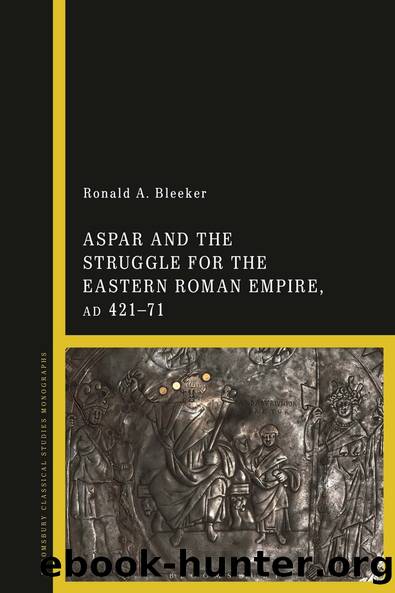Aspar and the Struggle for the Eastern Roman Empire, AD 42171 by Ronald A. Bleeker;

Author:Ronald A. Bleeker; [Неизв.]
Language: eng
Format: epub
ISBN: 9781350279285
Publisher: Bloomsbury UK
Published: 2022-02-03T21:00:00+00:00
Crowning an Emperor
Leo was less distinguished than Marcian. Croke calls him âan unusual choice.â42 Unlike Marcian, there is no suggestion that he was a senator. However, like Marcian, he came from humble origins in the Balkans, had military experience, and was an orthodox Christian.43 In 457, he was a tribune leading a unit of soldiers stationed near Constantinople and under Asparâs command.44
A less-distinguished emperor required a more elaborate coronation, and Aspar stage-managed things to suit. A detailed description has been preserved in the Book of Ceremonies, a Byzantine court manual that was compiled in the tenth century but is based on a sixth-century source.45
Leo was first acclaimed as emperor by the soldiers, the senate, and senior government officials in a ceremony at the Hebdomon, just outside Constantinople.46 After his coronation by the patriarch, Leo spoke to his âmost valiant fellow soldiersâ and, to further earn their goodwill, wisely provided âfive nomismata and a pound of silver to each shield.â47
The role of the patriarch in this ceremony is of interest. As Bury points out, â[a]s there was no Augustus or Augusta to perform the ceremony of coronation, this duty was assigned to the Patriarch Anatolius, who had perhaps taken some part in the coronation of Marcian.â48 Pulcheria, as an Augusta, had been able to perform this act for Marcian in 450, but in 457 there was no one of Augustal rank in Constantinople to do the same for Leo.49 This time the job fell to the patriarch, perhaps because he had earlier participated in the coronation of Marcian, but certainly to provide Leo legitimacy with a display of religious support.50
The ceremony at the Hebdomon was followed by an elaborate procession through Constantinople to the imperial palace. It is in this procession that the dominant role of Aspar in the new regime was made plain for all to see. Aspar rode in the imperial carriage with Leo, and it was Aspar who presented Leo with the traditional gold crown on behalf of the senate of Constantinople. It was a visual image whose political significance could not have been missed by anyone in the city.51
Leoâs accession had the support of the army, the senate, the patriarch, and the peopleâit was not contested. At the end of that February day in 457, Aspar should have been pleased by the ease of the transition. Once again, he had made an emperor, and perhaps he had guaranteed a place for his family in the imperial houseâbut would his partnership with Leo last?
Download
This site does not store any files on its server. We only index and link to content provided by other sites. Please contact the content providers to delete copyright contents if any and email us, we'll remove relevant links or contents immediately.
Fanny Burney by Claire Harman(26250)
Empire of the Sikhs by Patwant Singh(22775)
Out of India by Michael Foss(16695)
Leonardo da Vinci by Walter Isaacson(12812)
Small Great Things by Jodi Picoult(6693)
The Six Wives Of Henry VIII (WOMEN IN HISTORY) by Fraser Antonia(5242)
The Wind in My Hair by Masih Alinejad(4850)
The Crown by Robert Lacey(4578)
The Lonely City by Olivia Laing(4576)
A Higher Loyalty: Truth, Lies, and Leadership by James Comey(4562)
The Iron Duke by The Iron Duke(4126)
Millionaire: The Philanderer, Gambler, and Duelist Who Invented Modern Finance by Janet Gleeson(4113)
Papillon (English) by Henri Charrière(3919)
Sticky Fingers by Joe Hagan(3916)
Joan of Arc by Mary Gordon(3792)
Alive: The Story of the Andes Survivors by Piers Paul Read(3741)
Stalin by Stephen Kotkin(3731)
Aleister Crowley: The Biography by Tobias Churton(3433)
Ants Among Elephants by Sujatha Gidla(3282)
